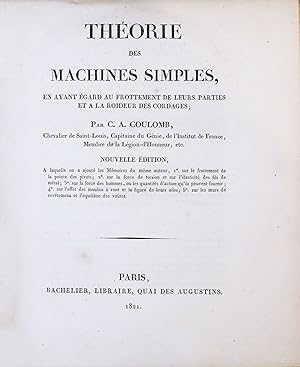Beschreibung
Paris, Bachelier, 1821 ; 4to, VIII, 368, (4) pages for Bachelier's advertising, and 10 folded plate ; contemporary half-calf. The first collected edition, in book form, of all major Coulomb's contributions in mechanics. Just before 1810, Bachelier bought the stock of the original printings, unsold, of the Académie des Sciences. At this time, around 1809, he proposed for sale a sammelband of Coulomb's original offprints with different collections (for an example see Norman 587). In 1821, when he had sold all his old stock he published, for the first time in an unique form book, the present collection on mechanics. "Coulomb s collected memoirs on mechanics. The first of these deals with simple machines and won the Academy prize of 1779. The second is a study of friction at pivots, and the third deals with torsion and the elasticity of metal wire. In the fourth memoir Coulomb discusses man s ability to perform work, quoting Daniel Bernoulli and d Alembert. The fifth memoir is devoted to windmills and the force of their wings, while the last is his famous memoir, Sur une application des regles de maximis et minimis a quelques problemes de statique relatif a l architecture (1773). The mathematical sections of the work were reviewed for publication by Jose Maria Lanz, co-author of the Essai sur la composition de machines." (Robert/Trent). "Coulomb s most celebrated study, one that brought him immediate acclaim, was 'Théorie des machines simples,' his prize-winning friction study of 1781. He investigated both static and dynamic friction of sliding surfaces and friction in bending of cords and in rolling. From examination of many physical parameters, he developed a series of two-term equations, the first term a constant and the second term varying with time, normal force, velocity, or other parameters. In agreement with Amontons s work of 1699, Coulomb showed that in general there is an approximately linear relationship between friction and normal force; but he extended the investigation considerably to show complex effects due to difference in load, materials, time of repose, lubrication, velocity, and other considerations. Coulomb s work in friction remained a standard of theory and experiment for a century and a half, until the advent of molecular studies of friction in the twentieth century. To quote Kragelsky and Schedrov s recent monograph (p. 52) on the history of friction: "Coulomb s contributions to the science of friction were exceptionally great. Without exaggeration, one can say that he created this science." "Another subject of much interest to Coulomb was the question of efficiency and output in work, and in this field (ergonomics) he made one of the most significant contributions before the studies of F. W. Taylor, a century later. Coulomb began this work in Martinique and read the first of several memoirs on the subject to the Academy in 1778. It was finally published in 1799 as Résultats de plusieure expériences destinées à déterminer la quantité d action que les hommes peuvent fournir par leur travail journalier, suivant les différent manières dont ils employent leurs forces. Earlier studies tested men or animals only for very brief periods, thus obtaining exaggerated results of productivity. Coulomb investigated various work parameters very realistically and with considerable psychological insight; and he distinguished between useful work and fatigue in work from living machines, solving to make the ratio of effect to fatigue a maximum. In this he produced the first real study of the practical aspects of labor allocation. Among his findings were that frequent rest periods during certain tasks produce higher overall output, and that maximum daily human work results from seven to eight hours labor for heavy tasks and ten hours labor for light tasks. He utilized similar isoperimetric methods to investigate the theory and design of windmills;"(DSB) A really great copy, clean inside with good margins. Rare. Norma. Bestandsnummer des Verkäufers YEG-12
Verkäufer kontaktieren
Diesen Artikel melden
![]()




